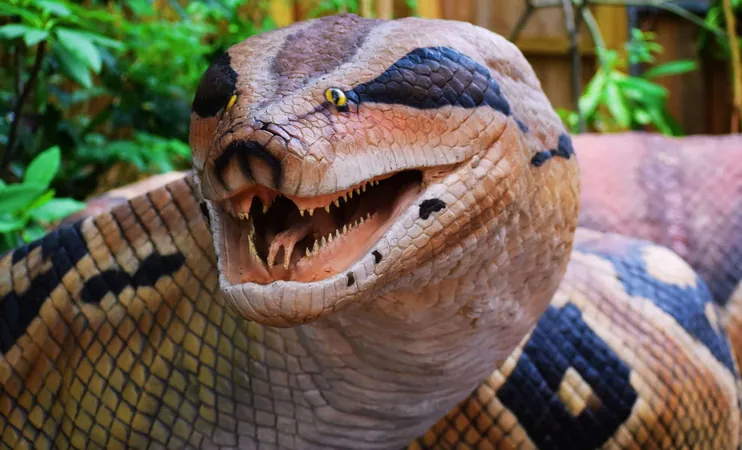
Unveiling the Colossal Vasuki Indicus: A 47-Million-Year-Old Snake Revolutionizes Our Understanding of Ancient Predators
2025-07-26
Author: Lok
A Groundbreaking Discovery in Paleontology
In a thrilling discovery, paleontologists have recently unveiled the fossil of a massive prehistoric snake, Vasuki indicus, that once slithered through the jungles of India a staggering 47 million years ago. This extraordinary find, emerging from the Panandhro Lignite Mine in Gujarat's Kutch region, reveals a serpent that stretched a breathtaking 50 feet and weighed more than 2,200 pounds. Conducted by a research team from the Indian Institute of Technology, this groundbreaking revelation not only enriches our understanding of ancient ecosystems but also sheds light on the evolution of snakes.
A Window into the Past
Unearthed from the rich stratigraphy of its mining location, the fossil comprises 27 remarkably preserved vertebrae, suggesting this species could be among the largest snakes ever recorded. The Middle Eocene period, when Vasuki indicus thrived, was marked by significant ecological transformations, heralding a time when lush tropical environments beckoned the rise of enormous predators. This discovery not only rewrites the narrative of snake evolution but also elevates the Kutch region to a vital hub for paleontological exploration.
The Predator Profile of Vasuki Indicus
What makes Vasuki indicus a captivating subject is its physical structure. Descriptions of its vertebrae hint at a thick, bulky body and broad vertebral architecture, indicating it was a slow-moving predator, likely relying on ambush techniques rather than speed to capture prey. Much like modern-day pythons, this ancient giant probably lay patiently in its tropical habitat, awaiting unsuspecting animals to strike.
A Cultural Connection: The Name Vasuki
The name Vasuki holds deep cultural resonance in India, as it alludes to a divine serpent revered in Hindu mythology. This connection not only underscores the snake's colossal presence but also celebrates the cultural significance of reptiles in Indian folklore. By naming this formidable creature after the mythological Vasuki, researchers intertwine science with cultural heritage, illustrating how ancient tales continue to shape our understanding of the natural world.
Illuminating Ancient Ecosystems
Vasuki indicus serves as a riveting glimpse into the ecosystem dynamics of the Middle Eocene. The findings illuminate how a warm, tropical climate enriched with diverse flora and fauna could support such magnificent creatures. With the prospect of abundant prey, the lush environments of prehistoric India likely provided an ideal setting for colossal predators to thrive.
An Evolutionary Milestone
Classified within the Madtsoiidae family, a group of ancient land-dwelling snakes that thrived over a span of 100 million years, Vasuki indicus adds a significant chapter to our understanding of reptilian evolution. While the family occupied diverse locales across ancient Gondwana, piecing together their evolutionary lineage has posed challenges due to the scarcity of fossil records.
Conclusion: A Blend of Science and Mythology
The discovery of Vasuki indicus is not just a paleontological triumph but also a testament to the interconnectedness of science and mythology. These remarkable findings compel us to rethink our perceptions of ancient life and its enduring legacy, reiterating the significant role these colossal beings played in shaping both the prehistoric world and our cultural narratives.



 Brasil (PT)
Brasil (PT)
 Canada (EN)
Canada (EN)
 Chile (ES)
Chile (ES)
 Česko (CS)
Česko (CS)
 대한민국 (KO)
대한민국 (KO)
 España (ES)
España (ES)
 France (FR)
France (FR)
 Hong Kong (EN)
Hong Kong (EN)
 Italia (IT)
Italia (IT)
 日本 (JA)
日本 (JA)
 Magyarország (HU)
Magyarország (HU)
 Norge (NO)
Norge (NO)
 Polska (PL)
Polska (PL)
 Schweiz (DE)
Schweiz (DE)
 Singapore (EN)
Singapore (EN)
 Sverige (SV)
Sverige (SV)
 Suomi (FI)
Suomi (FI)
 Türkiye (TR)
Türkiye (TR)
 الإمارات العربية المتحدة (AR)
الإمارات العربية المتحدة (AR)